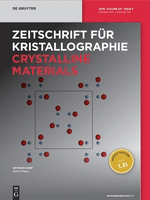
Zeitschrift fur Kristallographie-Crystalline Materials
Scope & Guideline
Transforming Ideas into Crystalline Reality
Introduction
Aims and Scopes
- Crystallization and Synthesis:
The journal emphasizes the synthesis of new crystalline materials, exploring various techniques such as mechanochemical synthesis, hydrothermal methods, and high-pressure synthesis to create novel compounds. - Structural Characterization:
Research articles frequently employ advanced characterization techniques, including X-ray diffraction, neutron diffraction, solid-state NMR, and electron microscopy to elucidate the crystal structures and properties of materials. - Material Properties and Applications:
A significant focus is placed on the relationship between structure and properties, including magnetic, optical, and electronic characteristics, as well as the potential applications of these materials in fields like electronics, catalysis, and biomedicine. - Supramolecular Chemistry:
The journal also covers research related to supramolecular structures, where the interactions and assembly of molecules lead to new functional materials, emphasizing the importance of intermolecular forces in crystallization. - Theoretical and Computational Studies:
In addition to experimental studies, the journal includes theoretical approaches, utilizing computational chemistry and crystallography to predict and analyze structural features and stability of materials.
Trending and Emerging
- Advanced Material Synthesis:
There is an increasing trend towards innovative synthesis methods, such as mechanochemical and high-pressure techniques, enabling the development of novel and complex crystalline materials. - Integration of Spectroscopic Techniques:
The use of spectroscopic techniques like solid-state NMR, Raman, and FTIR spectroscopy in conjunction with crystallography is becoming more prevalent, highlighting the importance of understanding material properties at a molecular level. - Nanomaterials and Applications:
Research focusing on nanocrystalline materials and their applications, particularly in energy conversion, catalysis, and biomedicine, is gaining momentum, reflecting increasing interest in sustainability and functional materials. - Interdisciplinary Approaches:
There is a noticeable increase in interdisciplinary research that combines crystallography with fields such as biology, physics, and engineering, promoting the development of hybrid materials and novel applications. - Structural Complexity and Disorder:
Emerging studies on the complexity of crystal structures, including disorder and non-stoichiometry, are becoming more common, indicating a growing recognition of the importance of these factors in material properties.
Declining or Waning
- Traditional Inorganic Structures:
There has been a noticeable decline in publications focusing solely on traditional inorganic crystal structures without novel applications or innovative synthesis methods, as the field shifts towards more complex materials with unique properties. - Basic Crystallographic Techniques:
Papers that solely discuss basic crystallographic techniques without integrating advanced methodologies or interdisciplinary approaches are becoming less frequent, likely due to the increasing complexity and specialization of research topics. - Low-dimensional Materials:
Research on low-dimensional materials, such as 1D and 2D structures, appears to be waning, possibly as researchers focus on more complex three-dimensional structures and their applications in advanced technologies. - Historical Reviews:
The frequency of historical reviews or bibliographic surveys related to crystallography has decreased, indicating a shift towards more novel research findings rather than retrospective analyses.
Similar Journals
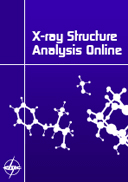
X-Ray Structure Analysis Online
Exploring Innovative Techniques in Analytical ChemistryX-Ray Structure Analysis Online is a pivotal academic journal dedicated to the field of analytical and materials chemistry, published by the Japan Society for Analytical Chemistry. Established in 2009, this journal serves as a vital platform for researchers and professionals dedicated to advancing the understanding of X-ray structural analysis techniques and their applications. With ISSN 1883-3578, it operates under rigorous peer-review standards, promoting high-quality research contributions. While the journal is currently categorized in the Q4 quartile for both Analytical Chemistry and Materials Chemistry, its focus on cultivating a deeper understanding of material properties through X-ray analysis remains crucial for ongoing developments in these fields. By providing an accessible outlet for innovative studies, X-Ray Structure Analysis Online supports the academic community in overcoming the challenges of a rapidly evolving scientific landscape. It is particularly valuable for those engaged in material and analytical research, offering insights that contribute to both theoretical foundations and practical applications.

Physics and Chemistry of Solid State
Exploring the Depths of Solid-State Phenomena and ChemistryPhysics and Chemistry of Solid State is a distinguished open access journal published by Vasyl Stefanyk Precarpathian National University in Ukraine, dedicated to advancing research in the fields of condensed matter physics, materials science, and physical and theoretical chemistry. Since its inception in 2000, the journal has provided a platform for the dissemination of innovative ideas and original research findings, contributing significantly to the global scientific community. With a variety of access options, it facilitates the sharing of knowledge and collaboration among researchers worldwide. The journal has garnered recognition with respectable rankings in Scopus, positioning itself among the significant publications in its domain, particularly noted for its contributions to materials science and condensed matter physics. As it moves through its converged years from 2018 to 2024, Physics and Chemistry of Solid State aims to foster interdisciplinary dialogue and prepare the next generation of scientists to tackle complex challenges in solid-state research.

JOURNAL OF NANOPARTICLE RESEARCH
Exploring the Frontiers of NanotechnologyJOURNAL OF NANOPARTICLE RESEARCH, published by SPRINGER, is a pivotal platform in the interdisciplinary field of nanotechnology, encompassing atomic and molecular physics, bioengineering, chemistry, condensed matter physics, and materials science. Operating since 1999 and converging through 2024, this journal presents cutting-edge research and innovations in nanoparticle science, aiming to bridge theoretical studies with practical applications. With a diverse scope that attracts articles ranked in various Q2 and Q3 category quartiles across its fields, including Bioengineering and Nanoscience and Nanotechnology, it ranks favorably within Scopus metrics, ensuring high visibility and impact among researchers. While the journal operates under traditional access models, it remains a critical resource for professionals and students alike, empowering them to advance their knowledge and drive future discoveries in this rapidly evolving area of study.

APPLIED PHYSICS A-MATERIALS SCIENCE & PROCESSING
Bridging Physics and Engineering for a Sustainable FutureApplied Physics A: Materials Science & Processing, published by Springer Heidelberg, is an esteemed academic journal that has been at the forefront of innovative research since its establishment in 1995. With a strong focus on the intersection of physics, materials science, and engineering, this journal explores cutting-edge developments and applications that influence contemporary materials research. Categorized in the Q2 quartile across both Chemistry and Materials Science, it boasts respectable rankings in Scopus, affirming its influence and reach within the academic community. Although primarily a subscription-based journal, it is dedicated to disseminating high-quality research findings that advance our understanding in these fields. Researchers, professionals, and students alike can benefit from the journal's commitment to publishing comprehensive studies, methodological advancements, and insightful reviews that push the boundaries of knowledge in materials science.

JOURNAL OF MATERIALS SCIENCE
Inspiring Excellence in Materials EngineeringJOURNAL OF MATERIALS SCIENCE, published by SPRINGER, stands as a highly regarded periodical in the field of materials science, delivering impactful research since its inception in 1966. With an impressive Q1 ranking in both Mechanical Engineering and Mechanics of Materials, alongside strong Q2 positions in Ceramics, Composites, and General Materials Science, this journal serves as a pivotal resource for scholars and practitioners alike. It offers insightful contributions that span a diverse range of topics, from emerging materials to advanced applications in engineering. With a robust Scopus ranking reflecting its global influence—ranking 91 out of 672 in Mechanical Engineering and 63 out of 398 in Mechanics of Materials—the JOURNAL OF MATERIALS SCIENCE maintains an essential role in advancing the understanding and innovation within the discipline. Researchers, professionals, and students are encouraged to access this esteemed journal to keep abreast of groundbreaking findings and methodologies that shape the future of materials science.
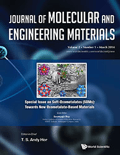
Journal of Molecular and Engineering Materials
Bridging Molecular Science with Engineering ExcellenceThe Journal of Molecular and Engineering Materials, published by World Scientific Publishing Co Pte Ltd, is a leading peer-reviewed journal that focuses on the intricate relationship between molecular science and engineering practices. With the ISSN 2251-2373 and E-ISSN 2251-2381, this journal aims to foster the exchange of cutting-edge research and developments within the fields of materials science, molecular engineering, and related applications. Although the journal currently does not operate under an Open Access model, it remains a vital resource for researchers, professionals, and students seeking in-depth knowledge and innovative methodologies in material design and engineering. The journal's esteemed reputation is reflected in its commitment to publishing high-quality research that addresses contemporary challenges and opportunities in material science, thereby contributing to advancements in technology and industry.
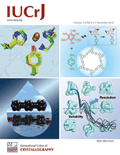
IUCrJ
Fostering Global Collaboration in Crystallographic ResearchIUCrJ, published by the International Union of Crystallography, is a leading open-access journal dedicated to advancing knowledge in the fields of Biochemistry, Chemistry, Condensed Matter Physics, and Materials Science. Since its inception in 2014, IUCrJ has quickly established itself as a prestigious platform for high-quality research, achieving a remarkable record as a Q1 journal across its categories in 2023. With an increasing impact in the scientific community, evidenced by impressive Scopus rankings, IUCrJ offers unparalleled access to groundbreaking discoveries and methodologies that contribute to the understanding and application of crystallography in various disciplines. The journal’s commitment to open access ensures that research is readily available to a global audience, fostering collaboration and innovation in the scientific community. IUCrJ is an essential resource for researchers, professionals, and students aiming to stay at the forefront of crystallographic research and its interdisciplinary applications.
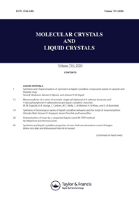
MOLECULAR CRYSTALS AND LIQUID CRYSTALS
Connecting Chemistry, Physics, and Material ScienceMOLECULAR CRYSTALS AND LIQUID CRYSTALS is a distinguished journal published by Taylor & Francis Ltd, dedicated to the comprehensive examination of the structural and physical properties of molecular crystals and liquid crystals, with applications spanning fields such as chemistry, materials science, and condensed matter physics. Established in 1972, this journal has carved out a niche in the academic landscape despite facing recent challenges, as reflected in its current quartile rankings of Q4 across multiple categories in 2023. The journal not only serves as a platform for groundbreaking research but also invites contributions that further explore the intricate relationships between molecular organization and material properties, thereby advancing our understanding of these fascinating substances. With a commitment to fostering scientific dialogue, MOLECULAR CRYSTALS AND LIQUID CRYSTALS aims to reach a broad audience of researchers, professionals, and students, providing insights that are pivotal in driving innovation in materials research.

DIAMOND AND RELATED MATERIALS
Pioneering insights into the world of diamonds.DIAMOND AND RELATED MATERIALS, published by Elsevier Science SA, serves as a premier international platform for the dissemination of high-quality research in the fields of materials science, electrical engineering, and chemistry, with a specialized focus on diamond and its related materials. With an ISSN of 0925-9635 and an E-ISSN of 1879-0062, this journal has established itself within the top quartiles, reflecting its influential contribution to the scientific community, particularly in the categories of Chemistry (miscellaneous) and Electrical Engineering, among others. The journal's wide scope encompasses both theoretical and applied aspects of diamond research, making it an essential resource for professionals and academics alike. The current rankings position it favorably within its respective disciplines, with a notable 79th percentile in General Physics and Astronomy and strong standings in related categories. Although it does not offer open access, researchers can stay informed of cutting-edge advancements and methodologies through its comprehensive articles and reviews, enriching the wider discourse in advanced materials research.

CRYSTENGCOMM
Unveiling the science of crystals for a transformative tomorrow.CRYSTENGCOMM is a distinguished journal published by the Royal Society of Chemistry, dedicated to advancing the field of crystallization and crystal engineering. With its impact factor consistently among the top tier in its category, CRYSTENGCOMM serves as an essential platform for researchers, professionals, and students in Chemistry, Condensed Matter Physics, and Materials Science. The journal has successfully maintained its relevance and influence since its inception, showcasing pioneering research from 1999 to 2024, with a commendable Q2 ranking in the latest evaluations. This accessibility to crucial developments in crystallization facilitates knowledge transfer across disciplines and enhances collaboration within the scientific community. Although it operates under a subscription model, the journal remains committed to disseminating cutting-edge research and fostering innovation in the field. For more information or to submit your research, please visit the Royal Society of Chemistry's website.